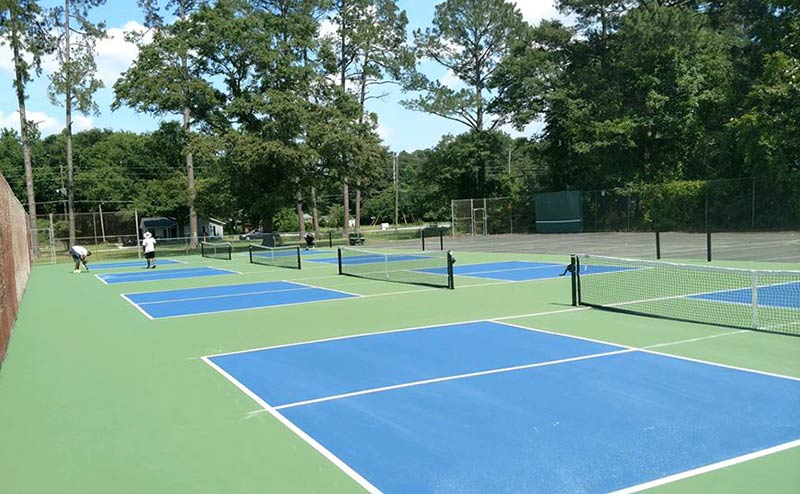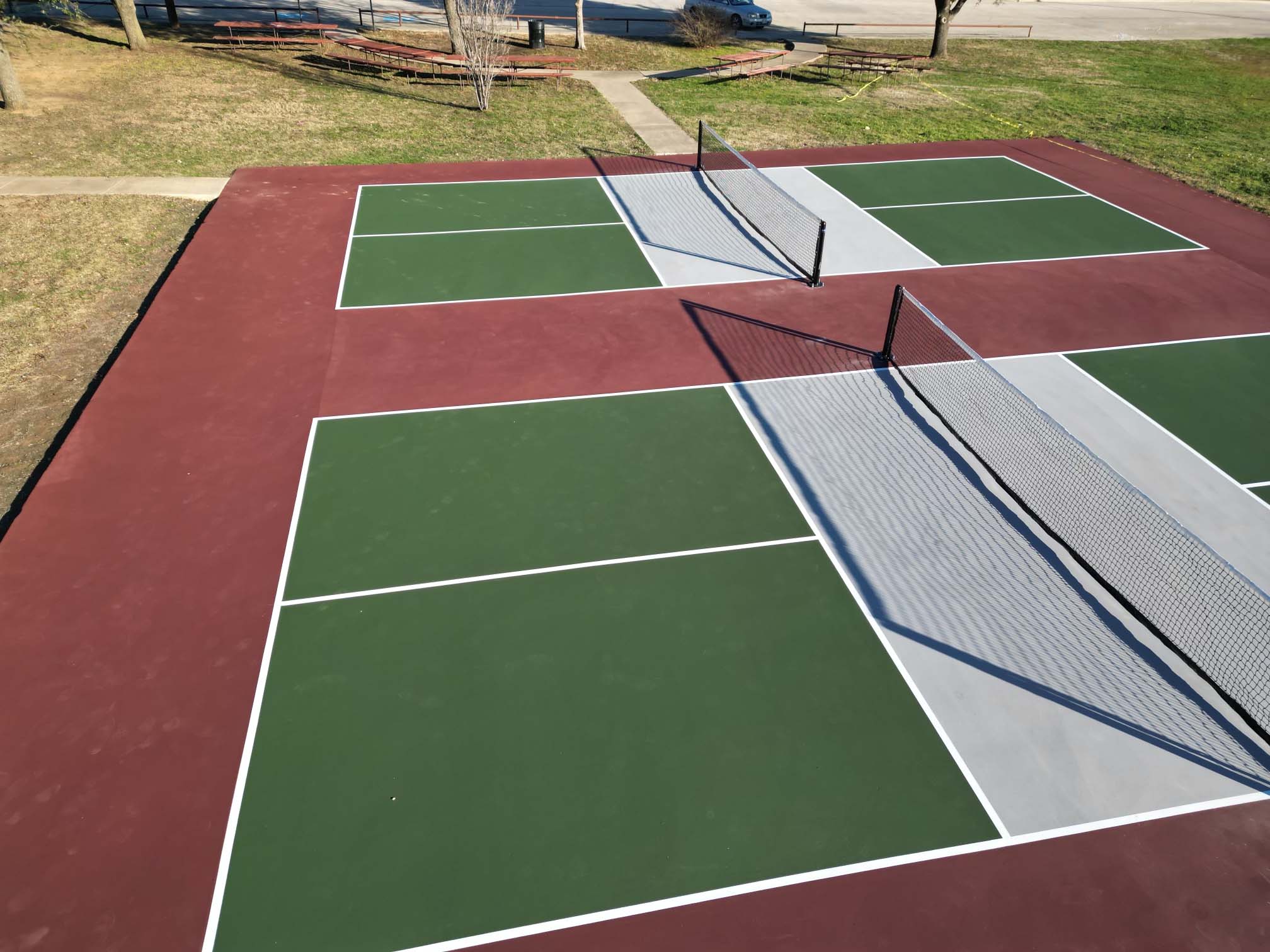Sustainable Practices in Pickleball Court Construction You Need To Know
As the appeal of pickleball continues to increase, so also does the need for sustainable practices in court building. This technique not only addresses environmental concerns however additionally boosts the long life and performance of the courts. From choosing environment-friendly materials to executing efficient water drainage and energy-saving lights remedies, there are many approaches to think about. Yet, the influence of these techniques prolongs much past the court itself. Understanding just how each element adds to a much more sustainable future welcomes even more expedition into the detailed balance in between leisure development and environmental stewardship.
Choosing Eco-Friendly Materials
Picking environmentally friendly products is a crucial step in the building of lasting pickleball courts. The selection of lasting materials not only lessens ecological effect yet likewise boosts the longevity and performance of the court. Key materials include recycled rubber for the surface, which offers superb sturdiness and shock absorption while diverting waste from garbage dumps.
In addition, utilizing in your area sourced products reduces transport exhausts and supports regional economies. Pickleball court construction. For instance, using native woods for fence and seats can offer a sustainable aesthetic while making certain durability against the aspects.
Incorporating permeable materials for court foundations can even more contribute to sustainability by permitting natural water drainage and reducing overflow. These selections not only safeguard neighborhood ecosystems however also advertise healthier play settings.
Effective Drainage Solutions
While the choice of environment-friendly materials is important, implementing effective drainage services is just as vital for maintaining lasting pickleball courts. Proper water drainage not only shields the court surface from water damage but additionally minimizes erosion and overflow, advertising ecological integrity.
Reliable drainage systems can include absorptive paving, which permits water to penetrate the ground instead of merging externally. This reduces the possibility of standing water, which can bring about mold and various other maintenance issues. In addition, incorporating tactically positioned water drainage channels and swales can direct excess water away from the court area, guaranteeing a completely dry having fun surface and stopping dirt erosion.
Utilizing indigenous plant life in the landscape design around the courts can further improve water drainage by taking in excess water and lowering runoff. These plants call for much less watering and advertise biodiversity, aligning with lasting techniques.
In addition, it is crucial to consistently keep the drainage system to ensure its lasting performance. This includes clearing particles and tracking for obstructions. By prioritizing effective water drainage remedies, pickleball court contractors can considerably add to the sustainability and long life of the center, inevitably benefiting both gamers and the environment.
Energy-Efficient Illumination Options
As the need for pickleball continues to expand, integrating energy-efficient illumination options into court layout has ended up being increasingly essential for sustainability. Traditional illumination systems commonly consume extreme power, adding to higher operational expenses and ecological impact. Adopting contemporary, energy-efficient innovations is crucial for both new buildings and renovations.
LED (Light Emitting Diode) illumination attracts attention as a premier choice because of its durability and power financial savings (Pickleball court construction). Contrasted to traditional illumination, LEDs make use of about 75% less energy and can last as much as 25 times longer, substantially reducing maintenance expenses. from this source The directional nature of LED lighting decreases light air pollution, ensuring that lighting is concentrated on the court rather than bordering areas.

Lasting Surface Alternatives
Checking out sustainable surface area options for pickleball courts has obtained traction among gamers and contractors alike. The emphasis on environment-friendly products not just straightens with the growing environmental awareness yet likewise boosts the performance and resilience of the courts.
One prominent choice is using recycled click to find out more rubber, which can be sourced from utilized tires. This product offers superb shock absorption, decreasing the risk of injuries for gamers while promoting sustainability. Additionally, modular ceramic tiles made from recycled plastics offer one more practical alternative. These tiles are simple to set up and replace, and their versatility permits for different court arrangements.
Natural lawn courts are also arising as a sustainable option, promoting biodiversity and reducing the heat island impact. They need routine upkeep and water, which might not align with all sustainability goals.

Water Conservation Methods

Another effective technique involves the installation browse around these guys of rainwater harvesting systems. These systems store and collect rain for usage in keeping court surface areas and landscaping. This method not only conserves safe and clean water however likewise minimizes dependence on municipal resources.
In addition, using drought-resistant landscaping around the courts is necessary. Indigenous plants require less water and are better adapted to local environment problems, thus decreasing overall water consumption. Additionally, utilizing reliable irrigation systems, such as drip watering, makes certain that water is provided straight to plant roots, decreasing evaporation and waste.
Verdict
Including sustainable practices in pickleball court construction significantly adds to ecological preservation and resource performance. By focusing on these practices, the building and construction of pickleball courts can line up with wider environmental objectives while promoting longevity and performance within communities.
As the appeal of pickleball proceeds to increase, so too does the need for lasting methods in court building and construction.Choosing eco-friendly products is an important action in the construction of sustainable pickleball courts. By focusing on energy-efficient lights options, pickleball court constructors can contribute to a more sustainable future while satisfying the requirements of stakeholders and gamers alike.Including lasting surface area choices not just boosts the efficiency of pickleball courts yet additionally leads the means for implementing efficient water conservation techniques.Integrating sustainable methods in pickleball court building and construction considerably contributes to environmental preservation and resource performance.